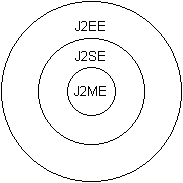







| |
Analysis
Overview of Java Technology
Java 2 Enterprise Edition (J2EE)
Designed for server-based applications.
Java 2 Standard Edition (J2SE)
Is a subset of J2EE.
Designed for desktop and workstation computers.
|

|
|
Java 2 Micro Edition (J2ME)
Is a subset of J2SE.
Designed for small devices with limited memory, display and
processing power.
|
MIDP Architecture
K Virtual Machine (KVM)
Is a virtual machine that meets the CLDC specification.
Connected Limited Device Configuration (CLDC)
Is the only configuration defined for J2ME at present.
Defines the essential APIs to all wireless mobile devices.
Mobile Information Device Profile (MIDP)
Is an extension to CLDC.
Defines a more specific APIs for a particular type of devices.
MIDlet
Is a Java application developed to the MIDP specification for mobile
devices.
MIDlet Lifecycle
Paused State
The MIDlet is not executing.
Entered after construction and by method pauseApp().
Active State
The MIDlet is running.
Entered by method startApp().
Destroyed State
The MIDlet is terminated.
Entered by method destroyApp().
|
 |
Why J2ME?
Advantages
Based on the knowledge of J2SE technology learnt from Advanced Programming
last year, time on studying J2ME technology can be significantly reduced.
Free development toolkits and emulators are available for J2ME development,
such as J2ME Wireless Toolkit and Palm OS Emulator.
Disadvantages
The tagline of Java technology, "Write Once, Run Anywhere TM.",
is not quite suitable for J2ME. Since features of J2ME devices can be various,
the performance of the same application can be various too. Therefore J2ME
coding is strategically device-dependent.
To keep the platform small and efficient, many useful components of J2SE
have been removed in J2ME, such as Abstract Window Toolkit. Moreover,
considering the limited memory, display and processing power of the devices,
MSIS must be seriously designed to adapt to such environment before
implementation.
|
